Presentation on the power quality and accuracy
- 1. POWER SYSTEM STATE ESTIMATION Presentation by Ashwani Kumar Chandel Associate Professor NIT-Hamirpur
- 2. Presentation Outline ŌĆó Introduction ŌĆó Power System State Estimation ŌĆó Solution Methodologies ŌĆó Weighted Least Square State Estimator ŌĆó Bad Data Processing ŌĆó Conclusion ŌĆó References
- 3. Introduction ŌĆó Transmission system is under stress. ’ā╝ Generation and loading are constantly increasing. ’ā╝ Capacity of transmission lines has not increased proportionally. ’ā╝ Therefore the transmission system must operate with ever decreasing margin from its maximum capacity. ŌĆó Operators need reliable information to operate. ’ā╝ Need to have more confidence in the values of certain variables of interest than direct measurement can typically provide. ’ā╝ Information delivery needs to be sufficiently robust so that it is available even if key measurements are missing. ŌĆó Interconnected power networks have become more complex. ŌĆó The task of securely operating the system has become more difficult.
- 4. Difficulties mitigated through use of state estimation ŌĆó Variables of interest are indicative of: ’ā╝ Margins to operating limits ’ā╝ Health of equipment ’ā╝ Required operator action ŌĆó State estimators allow the calculation of these variables of interest with high confidence despite: ’ā╝ measurements that are corrupted by noise ’ā╝ measurements that may be missing or grossly inaccurate
- 5. Objectives of State Estimation ŌĆó Objectives: ’āś To provide a view of real-time power system conditions ’ā╝ Real-time data primarily come from SCADA ’ā╝ SE supplements SCADA data: filter, fill, smooth. ’āś To provide a consistent representation for power system security analysis ŌĆó On-line dispatcher power flow ŌĆó Contingency Analysis ŌĆó Load Frequency Control ’āś To provide diagnostics for modeling & maintenance
- 6. Power System State Estimation ŌĆó To obtain the best estimate of the state of the system based on a set of measurements of the model of the system. ŌĆó The state estimator uses ’ā╝ Set of measurements available from PMUs ’ā╝ System configuration supplied by the topological processor, ’ā╝ Network parameters such as line impedances as input. ’ā╝ Execution parameters (dynamic weight- adjustmentsŌĆ”)
- 7. Power System State Estimation (Cont.,) ŌĆó The state estimator provides ’ā╝ Bus voltages, branch flows, ŌĆ”(state variables) ’ā╝ Measurement error processing results ’ā╝ Provide an estimate for all metered quantities. and unmetered ’ā╝ Filter out small errors due to model approximations and measurement inaccuracies; ’ā╝ Detect and identify discordant measurements, the so- called bad data.
- 8. State Estimation Analog Measurements Pi , Qi, Pf , Qf , V, I, ╬Ėkm Circuit Breaker Status State Estimator Bad Data Processor Network Observability Check Topology Processor V, ╬Ė
- 9. Power System State Estimation (Cont.,) ŌĆó The state (x) is defined as the voltage magnitude and angle at each bus i Vi Vej i ~ x [V1,V2,...,Vn , 1,..., b ] Measurement Model: h(x) ŌĆó All variables of interest can be calculated from the state and the measurement mode. z = h(x) I12 P12 V1
- 10. Power System State Estimation (Cont.,) ŌĆó We generally cannot directly observe the state ’ā╝ But we can infer it from measurements ’ā╝ The measurements are noisy (gross measurement errors, communication channels outage) Ideal measurement: H(x) Noisy Measurements z=h(x)+e Measurement: z
- 11. Consider a Simple DC Load Flow Example Three-bus DC Load Flow The only information we have about this system is provided by three MW power flow meters
- 12. (Cont.,) ’ü▒ Only two of these meter readings are required to calculate the bus phase angles and all load and generation values fully Now calculating the angles, considering third bus as swing bus we get M13 M32 5MW 0.05pu 40MW 0.40pu 13 1 3 13 13 32 3 2 32 23 1 ( f ) M 0.05pu x 1 ( f ) M 0.40pu x 1 2 0.02rad 0.10rad
- 13. Case with all meters have small errors s, If we use only the M13 and M32 reading as before, then the phase angles will be: This results in the system flows as shown in Figure . Note that the predicted flows match at M13, and M32 but the flow on line 1-2 does not match the reading of 62 MW from M12. 1 2 3 0.024rad 0.0925rad 0rad(still assumed to equal zero) M12 M13 M32 62MW 0.62pu 6MW 0.06pu 37MW 0.37pu
- 14. Power System State Estimation (Cont.,) ŌĆó The only thing we know about the power system comes to us from the measurements so we must use the measurements to estimate system conditions. ŌĆó Measurements were used to calculate the angles at different buses by which all unmeasured power flows, loads, and generations can be calculated. ŌĆó We call voltage angles as the state variables for the three- bus system since knowing them allows all other quantities to be calculated ŌĆó If we can use measurements to estimate the ŌĆ£statesŌĆØ of the power system, then we can go on to calculate any power flows, generation, loads, and so forth that we desire.
- 15. State Estimation: determining our best guess at the state ŌĆó We need to generate the best guess for the state given the noisy measurements we have available. ŌĆó This leads to the problem how to formulate a ŌĆ£bestŌĆØ estimate of the unknown parameters given the available measurement. ŌĆó The traditional methods most commonly encountered criteria are ’ā╝ The Maximum likelihood criterion ’ā╝ The weighted least-squares criterion. ŌĆó Non traditional methods like ’ā╝ Evolutionary optimization techniques like Genetic Algorithms, Differential Evolution Algorithms etc.,
- 16. Solution Methodologies ’āśWeighted Least Square (WLS)method: ’āśMinimizes the weighted sum of squares of the difference between measured and calculated values . ’āś In weighted least square method, the objective function ŌĆ×fŌƤ minimized is given by to be ’āśIteratively Reweighted Least Square Value (WLAV)method: (IRLS)Weighted Least Absolute ’āś Minimizes the weighted sum of the absolute value of difference between measured and calculated values. ’āśThe objective function to be minimized is given by m | pi| i 1 ’āśThe weights get updated in every iteration. m i i 1 2 i 1 e2
- 17. (Cont.,) ’āśLeast Absolute Value(LAV) method: ’āś Minimizes the objective function which is the sum of absolute value of difference between measured and calculated values. ’āśThe objective function ŌĆ×gŌƤto be minimized is given by g= m Subject to constraint zi= hi(x) + ei Where, Žā2 = variance of the measurement W=weight of the measurement (reciprocal measurement) of variance of the ei = zi-hi(x), i=1, 2, 3 ŌĆ”.m. h(x) = Measurement function, x = state variables and Z= Measured Value m=number of measurements i 1 W | h (x)-z | i i i
- 18. (Cont.,) ŌĆó The measurements are assumed to be in error: that is, the value obtained from the measurement device is close to the true value of the parameter being measured but differs by an unknown error. ŌĆó If Zmeas be the value of a measurement as received from a measurement device. ŌĆó If Ztrue be the true value of the quantity being measured. ŌĆó Finally, let ╬Ę be the random measurement error. Then mathematically it is expressed as Zmeas Ztrue
- 19. (Cont.,) ŌĆó 1 PDF( ) exp( 2 / 2 2 ) 2
- 20. 20 Probability Distribution of Measurement Errors 3 f(x) x 0 Gaussian distibution Actual distribution
- 21. Weighted least Squares-State Estimator ŌĆó The problem of state estimation is to determine the estimate that best fits the measurement model . ŌĆó The static-state of an M bus electric power network is denoted by x, a vector of dimension n=2M-1, comprised of M bus voltages and M-1 bus voltage angles (slack bus is taken as reference). ŌĆó The state estimation problem can be formulated as a minimization of the weighted least-squares (WLS) ŌĆó m i 1 (z h (x))2 i i 2 i function problem. min J(x)=
- 22. (Cont.,) ŌĆó This represents the summation of the squares of the measurement residuals weighted by their respective measurement error covariance. ŌĆó where, z is measurement vector. h(x) is measurement matrix. m is number of measurements. Žā2 is the variance of measurement. x is a vector of unknown variables to be estimated. ŌĆó The problem defined is solved as an unconstrained minimization problem. ŌĆó Efficient solution of unconstrained minimization problems relies heavily on NewtonŌƤs method.
- 23. (Cont.,) ŌĆó The type of NewtonŌƤs method of most interest here is the Gauss-Newton method. ŌĆó In this method the nonlinear vector function is linearized using Taylor series expansion h(x x) h(x) H(x) x ŌĆó where, the Jacobian matrix H(x) is defined as: h(x) H(x) x ŌĆó Then the linearized least-squares objective function is given by J( x) 1 (z h(x) H(x) x)T R 1 (z h(x) H(x) x) 2
- 24. (Cont.,) ŌĆó where, R is a weighting matrix whose diagonal elements are often chosen as measurement error variance, i.e., 2 1 2 m R Ōŗ▒ H(x) x) J( x) 1 (e(x) H(x) x)T R 1 (e(x) 2 ŌĆó where, e=z-h(x) is the residual vector.
- 25. (Cont.,) ŌĆó J( x) HT R 1 (e H x) 0 x HT R 1 H x HT R 1 e G x HT R 1 e
- 27. (Cont.,) ŌĆó To derive the [H] matrix, we need to write the measurements 1 as a function of the state variables 2 . These functions are written in per unit as and 1 2 1 2 1 3 1 32 32 3 2 2 M12 f12 1 ( ) 5 5 0.2 M13 f13 1 ( ) 2.5 0.4 1 M f ( ) 4 0.25
- 28. (Cont.,) ŌĆó [H] 5 5 2.5 0 0 4 2 M12 2 M12 2 M13 2 M13 2 M32 2 M32 0.0001 R 0.0001 0.0001
- 29. (Cont.,) ŌĆó 1 1 est 1 est 2 1 0.0001 0.0001 0.0001 5 5 2.5 0 0 4 0.0001 0.0001 5 2.5 0 -5 0 -4 5 2.5 0 -5 0 -4 0.62 0.06 0.0001 0.37
- 30. (Cont.,) ŌĆó We get ŌĆó From the estimated phase angles, we can calculate the power flowing in each transmission line and the net generation or load at each bus. est 1 est 2 0.028571 0.094286 (0.06 (2.5 ))2 (0.37 (4 ))2 J( 1, 2 ) 1 0.0001 2 0.0001 (0.62 (5 5 ))2 1 2 0.0001 2.14
- 31. Solution of the weighted least square example
- 32. Bad Data Processing ŌĆó One of the essential functions of a state estimator is to detect measurement errors, and to identify and eliminate them if possible. ŌĆó Measurements may contain errors due to ’ā╝ Random errors usually exist in measurements due to the finite accuracy of the meters ’ā╝ Telecommunication medium. ŌĆó Bad data may appear in several different ways depending upon the type, location and number of measurements that are in error. They can be broadly classified as: ’ā╝ Single bad data: Only one of the measurements in the entire system will have a large error ŌĆó Multiple bad data: More than one measurement will be in error
- 33. (Cont.,) ŌĆó Critical measurement: A critical measurement is the one whose elimination from the measurement set will result in an unobservable system. The measurement residual of a critical measurement will always be zero. ŌĆó A system is said to be observable if all the state variables can be calculated with available set of measurements. ŌĆó Redundant measurement: A redundant measurement is a measurement which is not critical. Only redundant measurements may have nonzero measurement residuals. ŌĆó Critical pair: Two redundant measurements whose removal from the measurement set will make unobservable. simultaneous the system
- 34. (Cont.,) ŌĆó When using the WLS estimation method, detection and identification of bad data are done only after the estimation process by processing the measurement residuals. J x (z h(x))'W z h(x) ŌĆó The condition of optimality is that the gradient of J(x) vanishes at the optimal solution x, i.e., ŌĆó An estimate z of the measurem ent vector z is given by ŌĆó The vector of residuals is defined as e = z - Hx; an estimate of e is given by GX ŌĆĖ H1 WZ 0 X ŌĆĖ G 1 H1 WZ Z ŌĆĖ HX e ŌĆĖ z h(x)
- 35. Bad Data Detection and Identification ŌĆó Detection refers to the determination of whether or not the measurement set contains any bad data. ŌĆó Identification is the procedure of finding out which specific measurements actually contain bad data. ŌĆó Detection and identification of bad data depends on the configuration of the overall measurement set in a given power system. ŌĆó Bad data can be detected if removal of the corresponding measurement does not render the system unobservable. ŌĆó A single measurement containing bad data can be identified if and only if: ’ā╝ it is not critical and ’ā╝ it does not belong to a critical pair
- 36. Bad Data Detection ŌĆó N i i 1 Y X2 2 k Y ~
- 37. Chi-square probability density function
- 39. (Cont.,) ŌĆó The degrees of freedom k, represents the number of independent variables in the sum of squares. ŌĆó Now, let us consider the function f(x), written in terms of the ŌĆó where e is theithmeasurement error, Rii is the diagonal entry of the measurement error covariance matrix and m is the total number of measurements. ŌĆó Then, f(x) will have a chi-square distribution with at most (m - n) degrees of freedom. where, m is number of measurements. n is number of state variables. 2 m m 2 1 2 N i i 1 i 1 e measurement errors: m f(x) i 1 Rii ei ei Rii
- 40. Steps to detection of bad data ŌĆó m i i j 1 f e2 / 2 .
- 41. Bad Data Identification ŌĆó ii (zi zi ) / R' ii R' (I HG 1 HT R 1 )R
- 42. Steps to Bad Data Identification ŌĆó i ii ei eN R' i=1,2,...m
- 44. Cont., ŌĆó Measurement equations characterizing the meter readings are found by adding errors terms to the system model. We obtain 1 1 2 1 2 1 2 2 3 1 2 3 4 1 2 4 5 x 1 x z e 8 8 z e 1 x 8 x 8 8 z e z e 3 x 1 x 8 8 1 x 3 x 8 8
- 45. (Cont.,) ŌĆó Forming the H matrix we get 0.625 0.125 0.125 0.625 0.375 0.125 0.125 0.375 H 100 0 0 0 0 100 0 0 0 0 50 0 0 0 0 50 W 9.01 3.02 6.98 5.01 z
- 46. (Cont.,) ŌĆó Solving for state estimates i.e., ŌĆó We get G 1 HT Wz V1 V2 16.0072V 8.0261V V1 V2
- 48. (Cont.,) ŌĆó 9.01 9.00123 0.00877A 3.02 3.01544 0.00456A 6.98 7.00596 0.02596V 5.01 5.01070 0.00070V e1 e2 e3 e4
- 50. (Cont.,) ŌĆó 1 2 3 4 [z z z z ]T [9.01A 3.02A 6.98V 4.40V]T [e e e e ]T [9.01A 3.02A 6.98V 4.40V]T 1 2 3 4 4 i 2 i f e2 / 100(0.06228)2 100(0.15439)2 50(0.05965)2 50(0.49298)2 j 1 15.1009
- 51. (Cont.,) ŌĆó ii R' (I HG 1 HT R 1 )R i ii ei eN R' i=1,2,...m
- 52. (Cont.,) ŌĆó 11 22 33 44 e1 0.06228 1.4178 R' e2 3.5144 R' e3 0.4695 (1 0.807) 0.01 0.15439 (1 0.807) 0.01 0.05965 (1 0.193) 0.02 R' e4 0.49298 3.8804 (1 0.193) 0.02 R'
- 53. Conclusion ŌĆó Real time monitoring and control of power systems is extremely important for an efficient and reliable operation of a power system. ŌĆó Sate estimation forms the backbone for the real time monitoring and control functions. ŌĆó In this environment, a real-time model is extracted at intervals from snapshots of real-time measurements. ŌĆó Estimate the nodal voltage magnitudes and phase angles together with the parameters of the lines. ŌĆó State estimation results can be improved by using accurate measurements like phasor measurement units. ŌĆó Traditional state estimation and bad data processing is reviewed.
- 54. References ŌĆó F. C. Schweppe and J. Wildes, ŌĆ£Power system static state estimation, part I: exact model,ŌĆØ IEEE Trans. Power Apparatus and Systems, vol. PAS-89, pp. 120-125, Jan. 1970. ŌĆó R. E. Tinney W. F. Tinney, and J. Peschon, ŌĆ£State estimation in power systems, part i: theory and feasibility,ŌĆØ IEEE Trans. Power Apparatus and Systems, vol. PAS-89, pp. 345-352, Mar. 1970. ŌĆó F. C. Schweppe and D. B. Rom, ŌĆ£Power system static-state estimation, part ii: approximate model,ŌĆØ IEEE Trans. Power Apparatus and Systems, vol. PAS-89, pp.125-130, Jan. 1970. ŌĆó F. F. Wu, ŌĆ£Power System State Estimation,ŌĆØ International Journal of Electrical Power and Energy Systems, vol. 12, Issue. 2, pp. 80-87, Apr. 1990. ŌĆó Ali Abur and Antonio Gomez Exposito. (2004, April). Power System State (1st Estimation Theory and Implementation ed.) [Online]. Available: http://www.books.google.com. ŌĆó Allen J wood and Bruce F Wollenberg. (1996, February 6). Power Generation, Operation, and Control (2nd ed.) [Online]. Available: http://www.books.google.com.
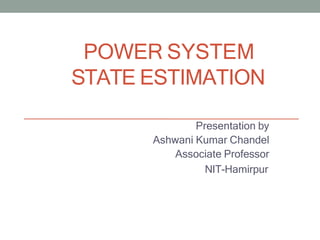
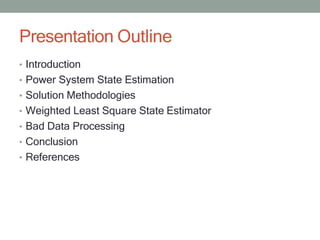
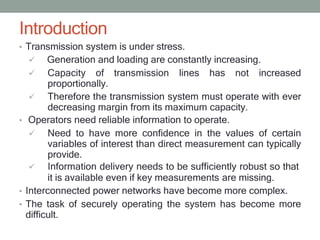

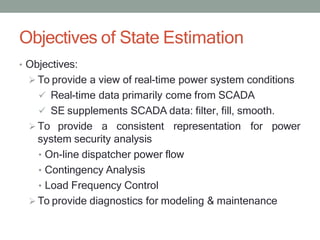
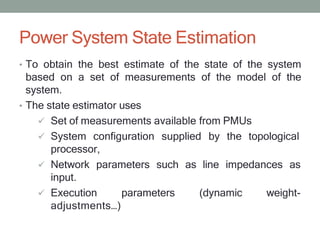
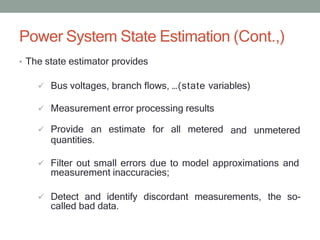
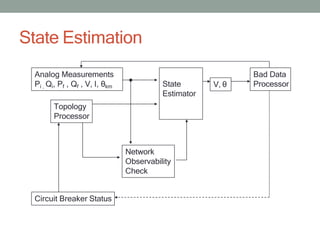
![Power System State Estimation (Cont.,)
ŌĆó The state (x) is defined as the voltage magnitude and
angle at each bus
i
Vi Vej i
~
x [V1,V2,...,Vn , 1,..., b ]
Measurement
Model: h(x)
ŌĆó All variables of interest can be calculated from the state
and the measurement mode. z = h(x)
I12
P12
V1](https://image.slidesharecdn.com/binjuppt-240322113624-e8953f46/85/Presentation-on-the-power-quality-and-accuracy-9-320.jpg)
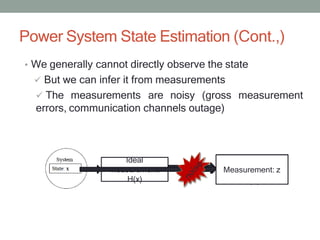

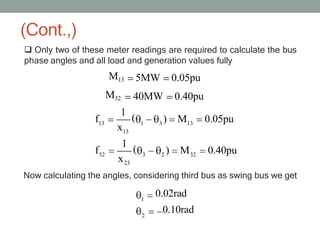
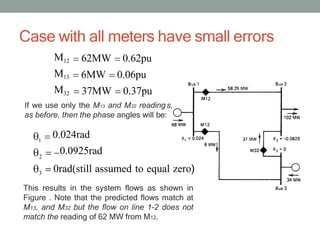
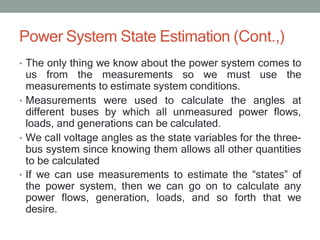
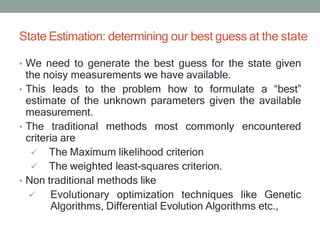

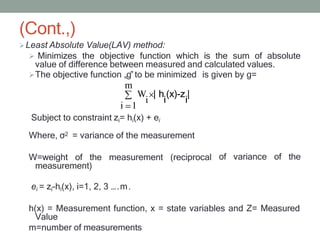
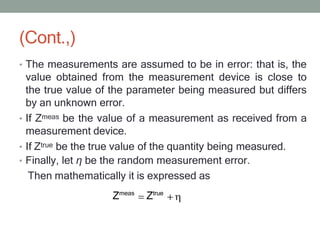
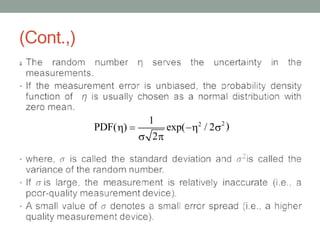
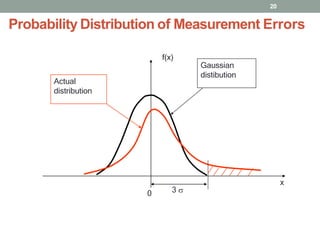
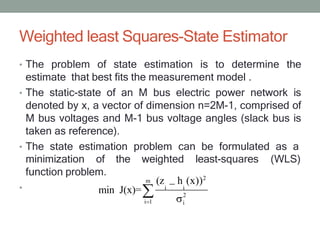

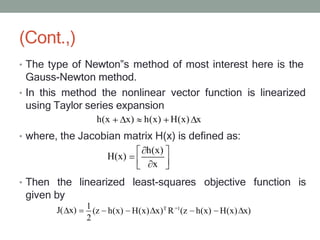
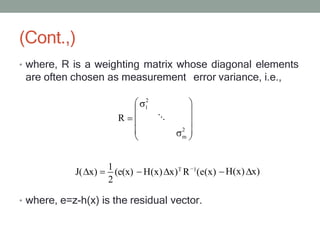
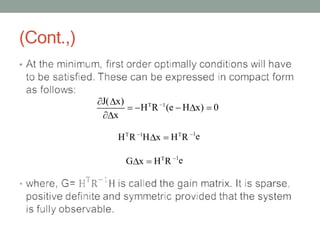
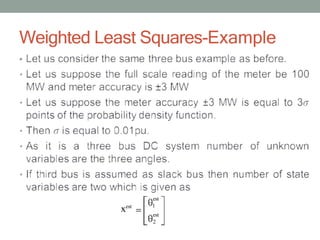
![(Cont.,)
ŌĆó To derive the [H] matrix, we need to write the measurements
1
as a function of the state variables 2 . These functions
are written in per unit as
and
1 2 1 2
1 3 1
32 32 3 2 2
M12 f12
1
( ) 5 5
0.2
M13 f13
1
( ) 2.5
0.4
1
M f ( ) 4
0.25](https://image.slidesharecdn.com/binjuppt-240322113624-e8953f46/85/Presentation-on-the-power-quality-and-accuracy-27-320.jpg)
![(Cont.,)
ŌĆó
[H]
5 5
2.5 0
0 4
2
M12
2
M12
2
M13
2
M13
2
M32
2
M32
0.0001
R 0.0001
0.0001](https://image.slidesharecdn.com/binjuppt-240322113624-e8953f46/85/Presentation-on-the-power-quality-and-accuracy-28-320.jpg)
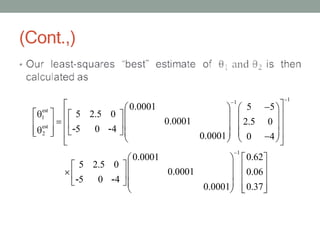


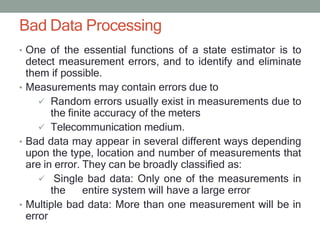
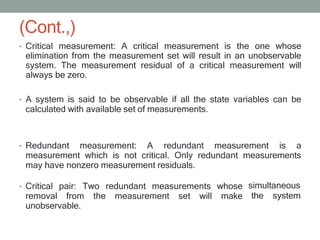

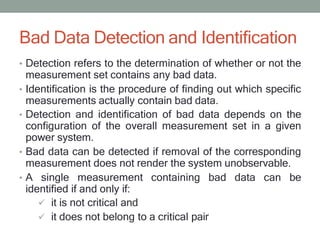
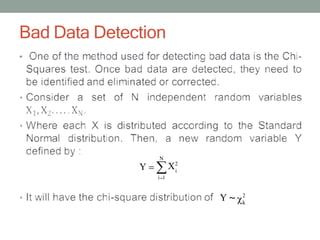
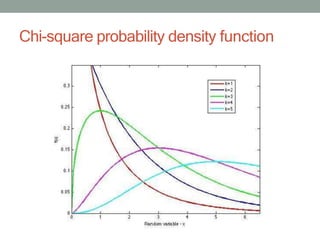
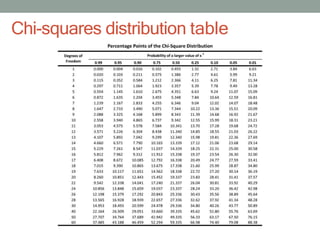
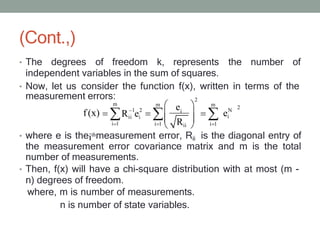


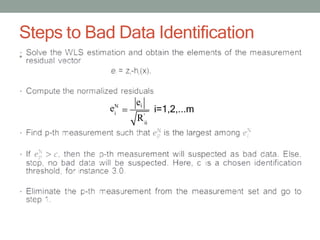
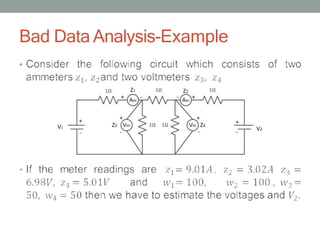
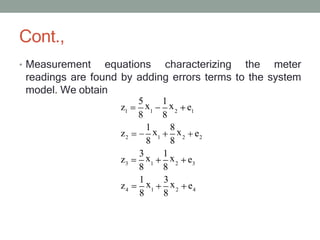
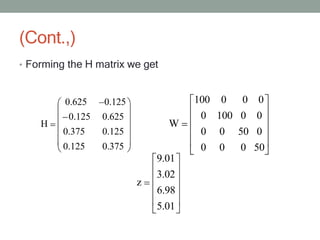
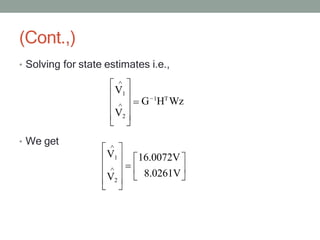

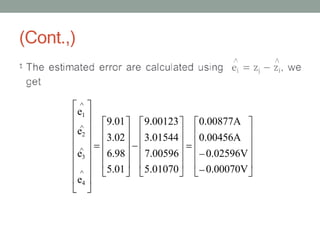

![(Cont.,)
ŌĆó
1 2 3 4
[z z z z ]T
[9.01A 3.02A 6.98V 4.40V]T
[e e e e ]T
[9.01A 3.02A 6.98V 4.40V]T
1 2 3 4
4
i
2
i
f e2
/ 100(0.06228)2
100(0.15439)2
50(0.05965)2
50(0.49298)2
j 1
15.1009](https://image.slidesharecdn.com/binjuppt-240322113624-e8953f46/85/Presentation-on-the-power-quality-and-accuracy-50-320.jpg)

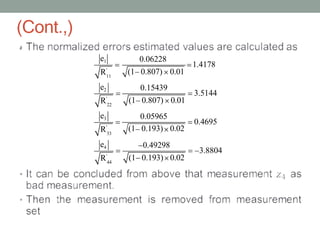
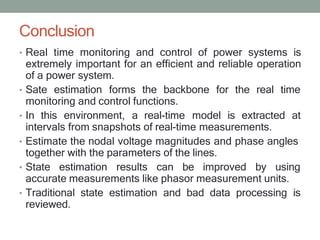
![References
ŌĆó F. C. Schweppe and J. Wildes, ŌĆ£Power system static state estimation, part I: exact
model,ŌĆØ IEEE Trans. Power Apparatus and Systems, vol. PAS-89, pp. 120-125,
Jan. 1970.
ŌĆó R. E. Tinney W. F. Tinney, and J. Peschon, ŌĆ£State estimation in power systems,
part i: theory and feasibility,ŌĆØ IEEE Trans. Power Apparatus and Systems, vol.
PAS-89, pp. 345-352, Mar. 1970.
ŌĆó F. C. Schweppe and D. B. Rom, ŌĆ£Power system static-state estimation, part ii:
approximate model,ŌĆØ IEEE Trans. Power Apparatus and Systems, vol. PAS-89,
pp.125-130, Jan. 1970.
ŌĆó F. F. Wu, ŌĆ£Power System State Estimation,ŌĆØ International Journal of Electrical
Power and Energy Systems, vol. 12, Issue. 2, pp. 80-87, Apr. 1990.
ŌĆó Ali Abur and Antonio Gomez Exposito. (2004, April). Power System State
(1st
Estimation Theory and Implementation ed.) [Online]. Available:
http://www.books.google.com.
ŌĆó Allen J wood and Bruce F Wollenberg. (1996, February 6). Power Generation,
Operation, and Control (2nd ed.) [Online]. Available:
http://www.books.google.com.](https://image.slidesharecdn.com/binjuppt-240322113624-e8953f46/85/Presentation-on-the-power-quality-and-accuracy-54-320.jpg)